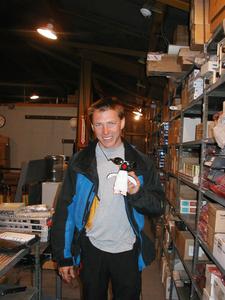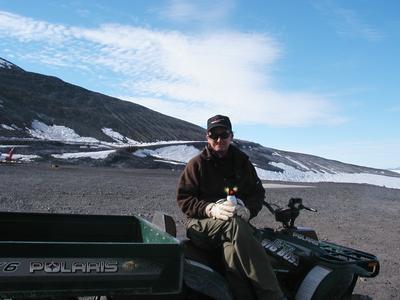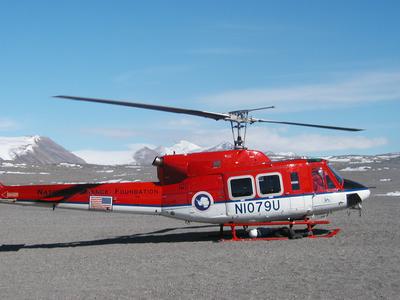
|
|
10 December, 2001

Heather Schutt is working under contract for Raytheon Polar Services to support science in Antarctica. She and her husband, Dave (a firefighter), will be in Antarctica from October until February. Heather is working in the communication/technology supply building to provide computers, modems, satellites, cables, field party radios, and other communication supplies as needed to further science research on this remote continent. Since McMurdo Research Station is thousands of miles away from the nearest "Radio Shack", all supplies must be ordered a year in advance. A vessel that comes every January will off-load cargo for the following year. The freighter will take all retrograde (i.e. waste, broken parts and equipment), which has been loaded in milvans (big, red, metal storage containers) back to Port Huenume, California. Heather graciously gave "Spike" and me a tour of the supply building.

Eric Lashinski from Colorado is a factory field engineer with Acuson, which specializes in diagnostic imaging using ultrasound. He came to Antarctica for 10 to 14 days in order to check out two ultrasound machines. One machine is here in McMurdo, and the other ultrasound machine is at the South Pole. I met him at the communication/technology supply building during my interview with Heather. Since he was heading to the South Pole, he agreed to mail a postcard from the South Pole to my students at West Elementary in Mt. Juliet, Tennessee. (Thanks, Eric)

Since I am scheduled to depart Antarctica in the early morning hours of December 13th, I wanted to stop by and thank some of the people who linked our field camp at New Harbor to "civilization". I met with Kevin Raymond and Teri Fox at "helo ops" (helicopter operations) at the McMurdo Research Station. This is their first season in Antarctica. They will both be here from October until February. Kevin has worked for the forest service and fire suppression for the past 11 years in Idaho. Three years ago when OAS (Office of Aircraft Service) came to speak with the forest service about Antarctica, Kevin decided to apply to Raytheon Polar Services as a "helo tech" (helicopter technician) in order to get helicopter experience. As a "helo tech", Kevin Raymond's job entails flying with the pilots to assist in cargo handling, personnel briefing, loading and unloading helicopters, and helping to insure the safety of the aircraft. Since our research team relies on helicopters for transportation around Antarctica, we were fortunate to befriend many of the wonderful people who were part of the helicopter operations. I was most impressed with their diligence concerning safety. We were required to wear our ECW (Extreme Cold Weather) gear on every flight, along with a helmet. Before loading the helicopter, everyone was weighed along with all gear and cargo. Either the "helo techs"or pilots would brief us each time in regard to the location of the fire extinguishers, survival gear, and radios. We were also instructed repeatedly on how to open the doors, how to position ourselves in case of a crash, and how to advance toward or leave the aircraft. A VHF (very high frequency) radio is placed on board near the pilot, along with an ELT (Emergency Locator Transmitter). The ELT is located inside the helo toward the rear of the aircraft. It can send signals for about 50 hours when activated during a crash. Any fear of flying in a helicopter was alleviated due to the constant measures taken to insure safety. Along with safety issues, keeping to a strict schedule is imperative. Teri Fox, from Seattle, Washington, is involved with scheduling flights and working out the details of each mission. She is in contact with the aircraft while they are out in the field. Each science research project is given an allotted number of "helo" hours to use for the season. Teri keeps track of these hours and assists the grantees as they plan the best use of this valuable time. A "helo-request form" must be submitted and scheduled a day or so in advance of the requested time.

Sarah Krall, another "helo tech", is from Wyoming. She has come to Antarctica 17 times, while her husband, a heavy equipment operator in Antarctica, has been 18 times. Sarah, who formerly taught biology, worked for National Outdoor Leadership School for 20 years. She is also a seasonal horsepacker (taking people on horsepacking trips in Montana). As I took the time to talk to scientists and the people involved in the day-to-day operations of McMurdo, I realized how these incredible, adventurous people made science research possible in such a harsh, remote land.

McMurdo has two Bell 212 helicopters that can each carry a maximum of 2200 pounds. A co-pilot or "helo tech" travel with the pilot. This aircraft can carry up to nine passengers. There are also two "A-Star" helicopters at McMurdo, which can carry a maximum load of 1100 pounds each. These five-passenger helicopters can carry external (outside) and internal loads. The A-Star has an external cargo hook to carry anything too bulky or big for the inside of the helicopter. Kevin is securing the net around barrels that will be sent back to McMurdo as retro (i.e. human waste in barrels or empty fuel drums). The crew works a standard 10-hour shift with no flights on Sundays. The helicopters are scheduled to fly mainly in the Dry Valleys, but may fly as far as Terra Nova Bay near the Italian base.

Many thanks to "helo ops" and the National Science Foundation
Contact the TEA in the field at
.
If you cannot connect through your browser, copy the
TEA's e-mail address in the "To:" line of
your favorite e-mail package.
|
